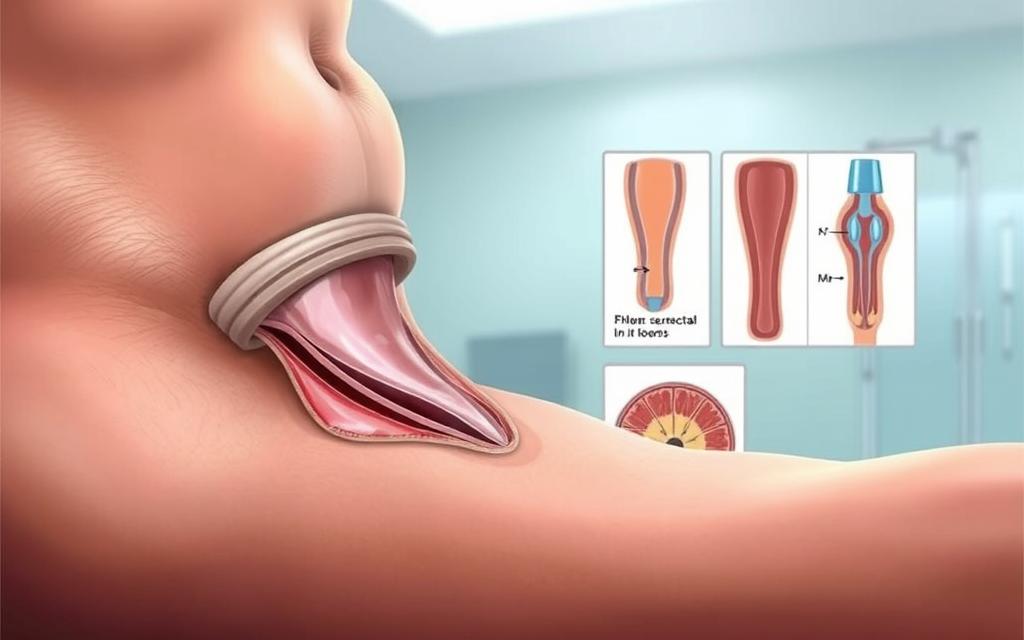Effective Treatment for Death Grip Erectile Dysfunction: Solutions and Cures
Death grip syndrome is a condition that affects many men, leading to erectile dysfunction due to excessive masturbation or other factors that result in desensitization.
Understanding that there are effective treatments available is the first step towards addressing this issue. Men experiencing symptoms of death grip syndrome can explore various treatment options to regain their sexual health.
By acknowledging the problem and seeking help, individuals can overcome the challenges posed by death grip syndrome and improve their overall well-being. It’s essential to approach this condition with a comprehensive understanding and the right guidance.
Understanding Death Grip Syndrome and Its Effects
Understanding death grip syndrome requires exploring how certain masturbation practices can desensitize the penis and affect erectile dysfunction. This condition is a significant concern for many men, as it directly impacts their sexual performance and overall well-being.
What Is Death Grip Syndrome?
Death grip syndrome occurs when an individual masturbates too aggressively, leading to desensitization of the penis. This desensitization can cause difficulties in achieving or maintaining an erection during sexual intercourse. The syndrome is often associated with vigorous masturbation techniques that reduce sensitivity over time.
How Death Grip Affects Sexual Performance
The aggressive masturbation associated with death grip syndrome can lead to erectile dysfunction by reducing penile sensitivity. Men experiencing this condition may find it challenging to achieve satisfaction during sexual activity, potentially straining their sexual relationships.
Signs You May Be Experiencing Death Grip ED
Recognizing the signs of death grip erectile dysfunction is crucial for seeking appropriate treatment. Common symptoms include reduced sensitivity and difficulty achieving or maintaining an erection. For more information on how lifestyle factors, including diet, can impact erectile dysfunction, visit Colorado Urologists to learn about the worst foods for erectile dysfunction.
By understanding the causes and symptoms of death grip syndrome, individuals can take the first steps towards addressing their erectile dysfunction and improving their sexual health.
Can Phimosis Cause Erectile Dysfunction?
Understanding the link between phimosis and erectile dysfunction requires a closer look at the physiological and psychological impacts of phimosis. Phimosis, a condition where the foreskin cannot be fully retracted over the glans penis, affects a significant number of men. It can lead to complications during sexual activities, potentially resulting in erectile dysfunction.
Defining Phimosis and Its Prevalence
Phimosis is generally categorized into two types: physiological and pathological. Physiological phimosis is common in children and often resolves on its own. Pathological phimosis, however, can result from inflammation, infection, or scarring. Studies indicate that a considerable percentage of men experience phimosis, though the prevalence varies across different age groups.
The condition can be caused by various factors, including:
- Infection or inflammation
- Poor hygiene
- Trauma or injury
- Conditions like diabetes
The Physiological Connection Between Phimosis and ED
Phimosis can directly impact erectile function through several mechanisms. For instance, the pain associated with phimosis can lead to erectile dysfunction due to the anxiety and stress it causes during sexual activity. Moreover, the condition can lead to a reduction in sexual desire due to the discomfort or pain experienced.

Men with phimosis may also experience a fear of causing further injury or pain during sexual intercourse, which can psychologically affect their ability to achieve or maintain an erection. For more information on treating erectile dysfunction, you can visit Colorado Urologists.
Psychological Factors: Pain, Anxiety, and Performance
The psychological impact of phimosis should not be underestimated. The condition can lead to significant distress, affecting a man’s self-esteem and sexual confidence. The fear of pain or discomfort during sexual activity can create a vicious cycle, exacerbating erectile dysfunction.
Addressing phimosis is crucial not only for alleviating its direct symptoms but also for mitigating its psychological effects. By understanding the interplay between phimosis and erectile dysfunction, men can seek appropriate treatments to regain their sexual health.
Diagnosing the Root Cause of Your ED
To address erectile dysfunction, it’s essential to determine whether it’s related to death grip syndrome, phimosis, or other factors. A proper diagnosis is crucial for effective treatment.
When to Consult a Healthcare Provider
If you’re experiencing persistent or recurring erectile dysfunction, it’s vital to consult a healthcare provider. They can help identify underlying causes and recommend appropriate treatments. Don’t hesitate to seek medical help if you’re concerned about your ED.
Differential Diagnosis: Death Grip vs. Phimosis vs. Other Causes
A healthcare provider will conduct a thorough evaluation to differentiate between death grip syndrome, phimosis, and other potential causes of ED. This process involves a physical exam, medical history, and possibly diagnostic tests. Accurate diagnosis is key to effective treatment.
Medical Tests and Evaluations
Medical tests and evaluations may include assessing blood flow, checking for nerve damage, or evaluating hormone levels. In some cases, additional tests might be necessary to rule out underlying conditions contributing to ED. These tests help healthcare providers develop a personalized treatment plan.
By understanding the root cause of your ED, you can work with your healthcare provider to develop an effective treatment strategy.
Treatment Options for Death Grip Erectile Dysfunction
Effective treatment for death grip ED encompasses a variety of medical and therapeutic interventions. Individuals can explore different approaches to manage their condition and improve their sexual health.
Masturbation Technique Modifications
One of the primary methods to address death grip ED is by modifying masturbation techniques. This can involve changing the way one masturbates to reduce excessive stimulation that may lead to desensitization.
- Using a looser grip during masturbation
- Avoiding vigorous or rapid movements
- Experimenting with different stroking patterns
These adjustments can help in regaining sensitivity and improving erectile function.
Abstinence and Sensitivity Training
Another approach is to incorporate periods of abstinence or sensitivity training. This involves taking breaks from masturbation to allow the body to regain its natural sensitivity.
Sensitivity training exercises can also be beneficial. These exercises are designed to help individuals become more aware of their bodily sensations and can improve sensitivity over time.
Specialized Tools and Devices
There are various specialized tools and devices available that can aid in the treatment of death grip ED. These include:
| Device | Description | Benefits |
|---|---|---|
| Desensitization reduction devices | Devices designed to reduce desensitization effects | Improved sensitivity, enhanced pleasure |
| Sensitivity training tools | Tools to help regain natural sensitivity | Better erectile function, increased awareness |
Therapy and Counseling Approaches
Therapy and counseling can play a crucial role in addressing the psychological aspects of death grip ED. Cognitive-behavioral therapy (CBT) and sex therapy can help individuals address underlying issues that may be contributing to their condition.
These therapeutic approaches can provide individuals with the tools and support needed to overcome their ED and improve their overall sexual well-being.

Managing and Treating Phimosis-Related ED
Phimosis, a condition characterized by a tight foreskin, can significantly impact erectile function, necessitating effective management and treatment strategies. Men experiencing erectile dysfunction due to phimosis have various treatment options available, ranging from non-surgical interventions to surgical procedures.
Non-Surgical Treatments for Phimosis
Initial treatment for phimosis often involves topical steroids, which can help loosen the foreskin, making it easier to retract. This approach is particularly effective for mild cases and can be administered under the guidance of a healthcare provider. For more information on managing erectile dysfunction, consider exploring resources on testosterone boosters.
Surgical Options: Circumcision and Preputioplasty
In cases where non-surgical treatments are ineffective, surgical options may be considered. Circumcision and preputioplasty are two procedures that can address phimosis. Circumcision involves the removal of the foreskin, while preputioplasty is a more conservative approach that preserves the foreskin. Both procedures have their benefits and should be discussed with a healthcare provider to determine the best course of action.
Recovery Timeline and Expectations
The recovery timeline for phimosis treatment varies depending on the chosen treatment method. Non-surgical treatments typically have a shorter recovery period, while surgical procedures may require several weeks for full recovery. Understanding the recovery process and expectations can help manage post-procedure care effectively.
Lifestyle Changes to Support Recovery
Making certain lifestyle adjustments can support recovery and overall sexual health. This includes maintaining good genital hygiene, avoiding irritants, and adopting healthy habits. By combining these lifestyle changes with appropriate medical treatment, individuals can improve their chances of successful recovery and reduced risk of complications.
Conclusion: Reclaiming Your Sexual Health
Erectile dysfunction is a common condition affecting millions of men worldwide. Understanding its causes and exploring available treatment options is crucial for reclaiming your sexual health. By addressing the root causes, whether it be death grip syndrome, phimosis, or other underlying health issues, individuals can work towards overcoming erectile dysfunction.
Treatment success often depends on a combination of lifestyle changes, medical interventions, and therapy. For instance, Cialis (tadalafil) has been shown to be effective in treating erectile dysfunction, with effects lasting up to 36 hours. Additionally, adopting a balanced diet, engaging in regular physical activity, and managing stress can significantly improve erectile function.
Reclaiming your sexual health requires a proactive approach. By seeking professional help and exploring the various treatment options available, individuals can overcome erectile dysfunction and enhance their overall well-being. Taking the first step towards understanding and addressing the underlying causes of erectile dysfunction is key to achieving success in treatment and improving sexual health.
